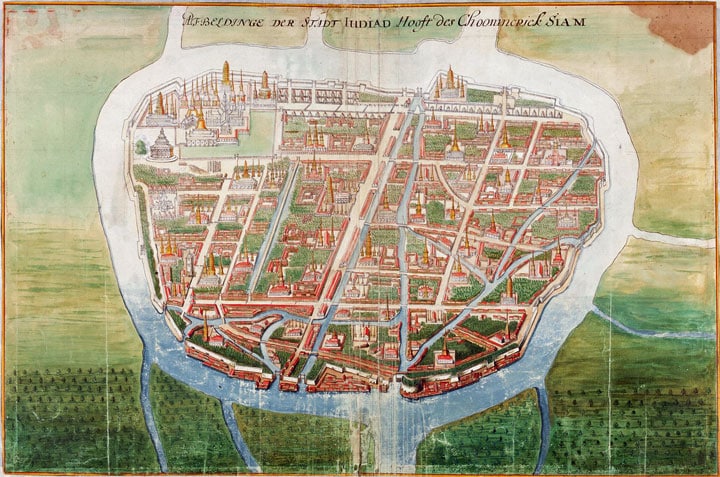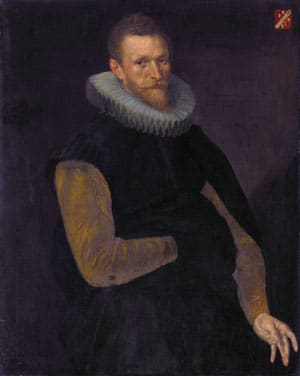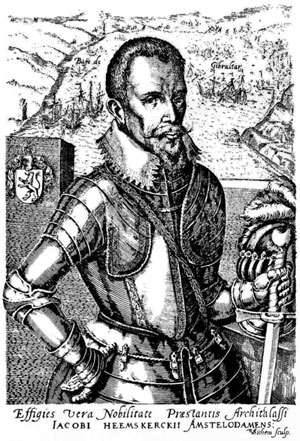The experiences of Jacobus van de Koutere, a Bruges adventurer in Siam and surroundings (part 2)

Ancient map of Ayutthaya – Photo: Wikipedia
Just like many farang today van de Koutere was also intrigued by the Siamese attitude towards sexuality:
"Next to these things I have seen among the inhabitants of that kingdom and those of Pegu, that all the great lords, the middle class, and even the petty folk, bear on the head of the penis two bells, which are penetrated into the flesh. They call the bubbles bruncioles. They appear the same size as notes and sound very clear; the big lords wear two and even four more. In the company of five Portuguese I visited a mandarin. He had just ordered to call a surgeon to remove one of the bruncioles from him, because it had hurt him. As was the custom in that country, this surgeon unashamedly removed that bubble before our very eyes. First, he used a razor blade to open the head of the head and extract one bubble. He sewed up the glans, to later, when it was healed, to repeat the operation and put the removed bubble back in. It's amazing how they can relate to this gaudy stuff. They told me afterwards about its inventor, a queen of Pegu. For in her time the inhabitants of that kingdom were very fond of homosexual practices. She enacted a law of the most severe punishment, that women should keep their underskirts open from the navel to the bottom, so that their thighs were uncovered when they walked. She did that so that the men would have more taste in women and would abandon sodomy…”
In his colorfully penned memories, Van de Koutere discussed numerous subjects that had affected him in Siam, from elephant hunting to the cowardice of the Siamese men to the gruesome corporal punishment that the Siamese king had applied. In one of the most interesting passages, he confirmed that the Siamese capital was full of looted art that the Siamese had stolen from Cambodia. All these artifacts were later irretrievably lost after the fall and sack of Ayutthaya by the Burmese in 1767:
"Inside the temples there were many lamps and bronze statues all around; as high as a full grown man leaning against the walls. They were dressed like ancient Romans and some of them had sticks in their hands; others held chained lions. These solid bronze statues seemed very lifelike. Forty years ago these statues were found in a destroyed city of the kingdom of Cambodia. The inhabitants found this city in the mountains and did not know which people had lived there. The find was named 'Angkor'. Judging by the quality of the images found, the inhabitants were probably Romans…”

Jacob Cornelisz Van Neck
The number of images van de Koutere came across was in any case very impressive. According to him, there were no less than 3.000 in one large hall of a temple near the palace 'idols'....
However, his stay in Ayutthaya came to an abrupt end after he became involved in the intrigues of the Dominican Jorge de Mota and had to flee headlong. In the spring of 1602 he almost lost his life again after a confrontation with the VOC in the harbor of Pattani. Despite the warnings about the Dutch presence, he was moored in this harbor with a fully loaded junk. In the last week of September 1602, the Dutch captain - and later mayor of Amsterdam - Jacob Cornelisz Van Neck had sent out a reconnaissance team in sloops near Macau that had been captured by the Portuguese and of which everyone - with the exception of the minors on board - had been executed. Ignorant of their adventures, after no one returned, Van Neck had weighed anchor on October 3 and sailed to Pattani to establish a trading post for the pepper trade.

VOC Admiral Jacob Van Heemskerck
Precisely at the moment that van de Koutere also arrived in Pattani, three days later the VOC admiral Jacob Van Heemskerck also arrived there with news about the tragic fate of the Dutch who had fallen into Portuguese hands. Van Hemskerk had six Portuguese prisoners of war on board and van de Koutere prevented them from being hanged as a reprisal. Despite the fact that he was invited a few times on board the VOC ships to dine there, it was clear that the Dutch distrusted him and that this was mutual. Every evening van de Koutere retreated to the country because he did not trust the business and that was rightly witnessed by the following passage from his memoirs:
"I realized I couldn't defend the junk on my own if anything happened at night. I went to sleep on the land and entrusted the guard of the loaded junk to only four slaves. At nightfall the Dutchmen came and pierced the boat at the bow and stern, slowly but surely filling the vessel with water. When the slaves woke up around midnight, the junk had almost sunk. One of them came to warn me and I immediately set out to see if there was anything to save. When I arrived at the harbor the junk was full of water on the bottom; because it was low tide. I insisted on watching, furiously angry, but I couldn't help it. The sea came up so that the junk overturned. Because of this I again lost everything I owned…”.
Van de Koutere had been smart enough to let himself be accompanied in Pattani seven days a week, day and night, by a bunch of Japanese mercenaries and that was a good thing because the VOC wanted to kill him. The Dutch and their local accomplices succeeded in killing his local contact, a certain Antonio de Saldhana, and besieged the house in which van de Koutere stayed, but eventually had to evacuate empty handed.
After his unfortunate confrontation with the VOC, Jakobus van de Koutere devoted himself entirely to the trade in precious stones, mainly doing business with the Indian principality of Bijapur, and this did him no harm. In May 1603 he married Dona Catarina do Couto in Goa. A marriage that was blessed with two sons. Three years later, as a courier of the Spanish-Portuguese crown, he undertook an adventurous journey overland to embark via Baghdad and Allepo to Lisbon. In the Mediterranean, however, he was captured by Moorish pirates and imprisoned as a Christian galley slave in a Tunisian fortress. However, with French support, he could be ransomed. In the following years he tirelessly traveled through the Far East in search of fortune and experienced numerous adventures in which unreliable Eastern despots, petty Portuguese officials, Dutch VOC looters, cruel Malay pirates and ruthless Arab caravan robbers played a leading role.
After he returned to Goa, however, it soon became apparent that the Koutere brothers had gotten along well with the Portuguese. Until then they had managed to avoid being expelled from the Eastern colonies on the basis of two royal decrees from 1605 and 1606, like all non-Portuguese. By submitting petitions, their Portuguese husbands, skilfully balancing between Portuguese and Dutch interests and perhaps also quite a few bribes, they managed to stay out of harm's way for years to come, but in the spring of 1623 their song was over. They were arrested and deported to Lisbon where they ended up in prison on suspicion of collaboration with the Dutch…
A few months later, their business partner, the wealthy German Fernao do Cron, the Asian agent of the Fuggers, was also arrested and deported. In both cases, envy of these wealthy strangers may have played a part in the decision to arrest them and confiscate their property. However, the Spanish court managed to get the brothers released, after which Jacobus joined the colonial administration Madrid. He reported with great zeal to governors in the Indies how they could best chase away or boycott the VOC in the area. For example, he advocated not only the establishment of a standing army in India, but also the creation of a fleet of 12 heavily armed warships.of the Dunkirk type' and with mixed Flemish-Spanish crews to give the VOC a taste of its own medicine… It earned him a knighthood in the Order of St. James of the Sword, one of the oldest and most prestigious Spanish orders of knighthood.
Despite his busy activities, he found time in the years 1623-1628 to dictate his memories to his son Esteban, who wrote them in three volumes under the roaring title 'Vida de Jacques de Coutre, natural de la ciudad de Bruges, puesto en la forme que esta, por su hijo don Estevan de Coutre' bundled. The manuscript has since been kept in the National Library of Madrid and has had an English and a Dutch translation. The latter appeared in 1988, edited by Johan Verberckmoes and Eddy Stols, under the title 'Asian Wanderings – The Life Story of Jacques de Cotre, a Bruges Diamond Trader 1591-1627' at EPO.
Jacobus van de Koutere died in Zaragoza in July 1640, while he was in the Spanish royal retinue that was preparing to attack Catalonia. That van de Koutere had meanwhile become socially important is proven by the simple fact that in that sweltering summer people made the effort to transfer his remains to Madrid where, with royal permission, they were solemnly interred in a mausoleum in the chapel of San Andres de los Flamencos.


Very interesting to read about this history.
Very interesting piece. “the last week of September 1602” should be “1601”. Van Neck arrived at Patani on November 7, 1601. Van Heemskerk arrived on August 19/20, 1602. Van de Koutere arrived 3 days before Van Heemskerk, so that would have been around August 16/17, 1602. Between 20 and 22 August 1602 no less than 6 Dutch ships were docked in Patani. The arrival of the Koutere and the loss of its junk/cargo was new to me.
The nail on the head must indeed have been the last week of September 1601. This is what happens when you work on several historic articles at the same time and proofread them too sloppily. I promise on my solemn communion soul that I will read more carefully from now on... The account of our James about his adventure in Pattani was enlightening in more than one respect because, for example, he also confirmed the humane reputation that Van Neck enjoys in VOC historiography and he emphasized his courteous behavior, in contrast to the slightly rougher Van Heemskerck. The fact that no fewer than 1602 Dutch ships were anchored near Pattani in August 6 had everything to do with the VOC post for the pepper trade, which Jakobus described as a wooden house in 'Flemish' style….
Dear Lung Jan,
I enjoyed your historical story for 2 days, chapeau!!
For all European powers in the East, trade and war were inextricably linked. Jan Pietersz Coen said: 'War is trade and trade is war'.
There you immediately call the country's most (?) unpleasant man, who was also told from various quarters in his own time that things could be a bit more humane. I don't know the quotes by heart, but I hope many of you know by now that his successor (or what was his predecessor?) condemned JP's actions as unnecessarily brutal.
We have acquired an impressive reputation from that. The Netherlands gained the reputation of being the cruelest people on earth. For example, a Malay wrote in 1660: “Listen gentlemen, I beg you, never make friends with the Dutch! They behave like devils, where they go no country will be safe!”. Many a person has cursed the Dutch/VOC as devilish, untrustworthy, backward, false and cruel dogs.
Trade is war, war is trade. The VOC mentality. Do I still have a question or was that part of Dutch culture?
Nice story, a bit long. But otherwise you wouldn't understand, I think?
What struck me in this interesting diptych was that James and his brother Jozef are both married to a woman from the de Couto family. sisters?
Read with great pleasure. Very detailed and interesting story. I am truly amazed at all the dangers and adventures this man went through and also managed to survive.
Please more of this.